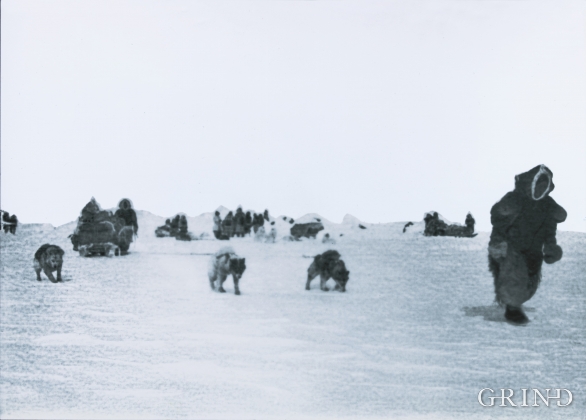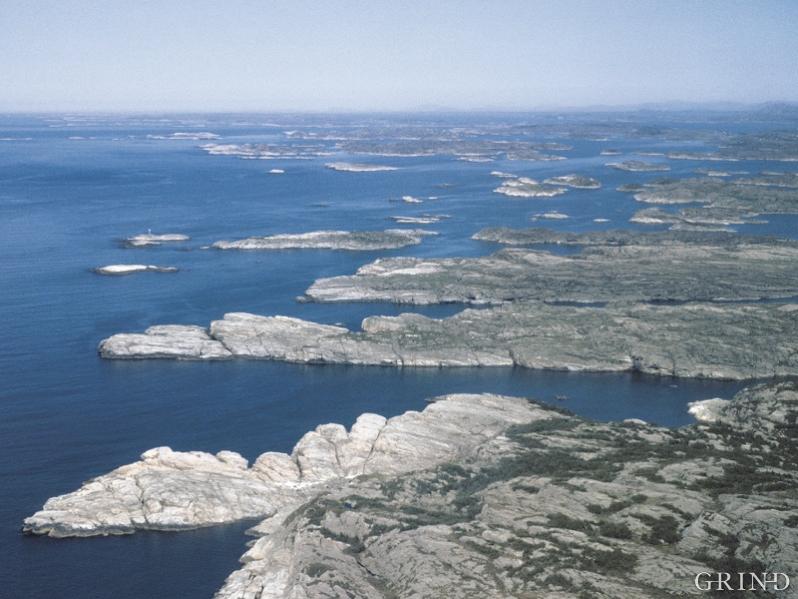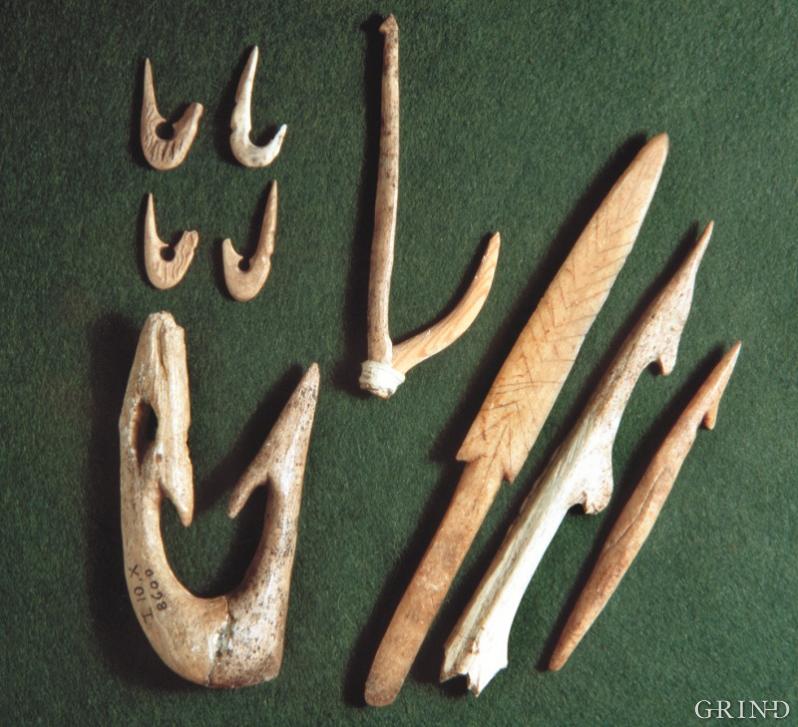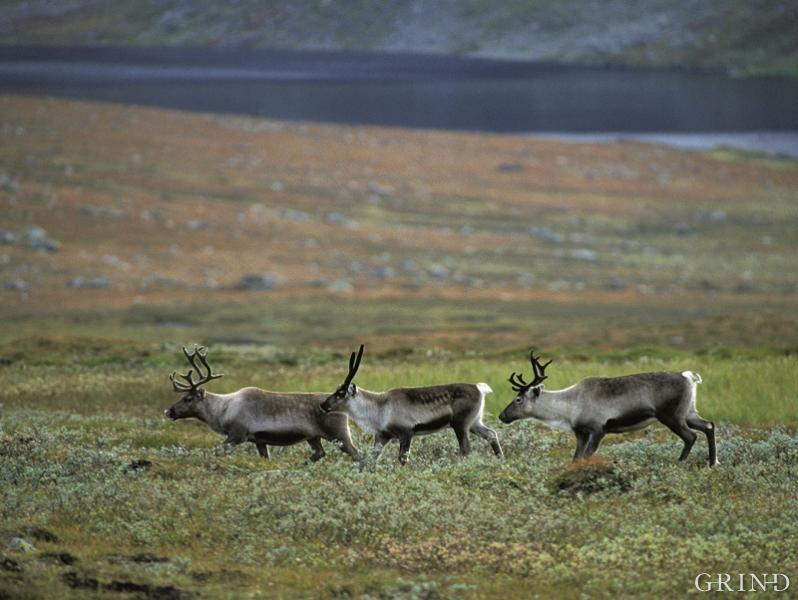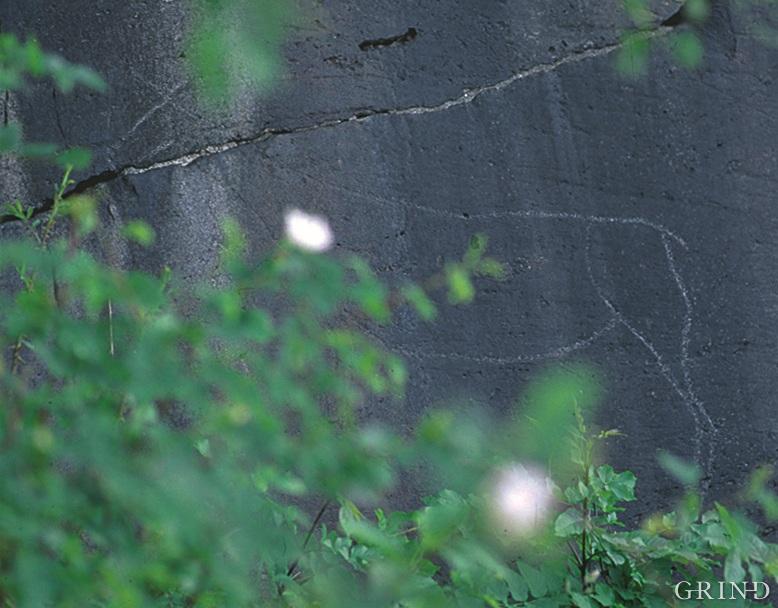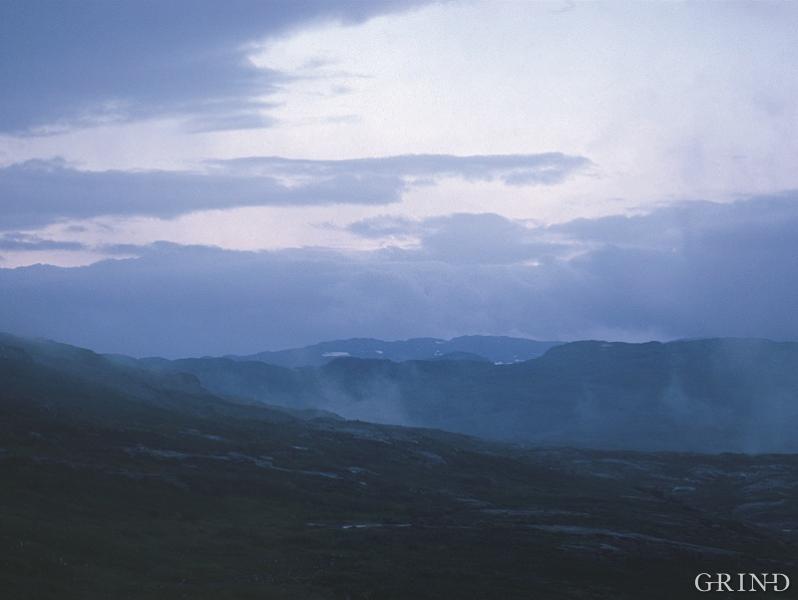Published: 19.05.2009 | Author: Svein Indrelid
Arctic hunting folk on their way across the ice. Is this the way the first human beings reached our country – across the ice from the North Sea Continent? (Photo from the 5th Thule Expedition 1921-24).(photo: Knud Rasmussen, owner: Etnologisk Samling, Nationalmuseet, København (neg. nr. 1700)).
HUNTING FOLK AND THE HUNTING SOCIETY
The saga regarding the settlement of Hordaland started off about 10,000 years ago. Most of this saga has been recorded in writing, not on paper, but on stone and on the earth in the forest and the marshes. Contemporary written sources that can tell us of life and fate in the distant times only go back about 1,000 years. Further back the sources are silent. All memories are forgotten. He who wishes to know something about the times before that will have to turn to the silent testimony from distant ancestors; the menhirs and stone crosses, to grave mounds along the routes, to inscriptions on the rock. Such great monuments from the past speak directly to us, and can convey to us something of the forgotten saga.
We do not have to go back many thousand s of years before the grave mounds and the rock inscriptions begin to diminish. This visible testimony of our history extends 3-4000 years back in time. The remainder of the saga lies buried beneath the turf.
But we can make even this eldest saga of ours visible to some extent. We can extract it from the earth. We can find remains from the settlements of our first hunting peoples. We can come across traces of a hearth, or a place of shelter, we can find flint remains and remains of a meal, a fishing weight, or a stone axe. In the bogs lie layer upon layer of pollen, the remains of plants and seeds, stored up for thousands of years. They have their tale to tell – on how people took charge of Nature and left their mark behind them on the vegetation and the landscape, long before the grave mounds and the rock inscriptions came along.
Such sources of information have given us thousands of bits of knowledge which enable us to get a glimpse of the day-to-day life of those who lived before we did and who are now forgotten.
The first hunting folk
There was still an Ice Age in this country when the first hunting folk settled on our shores. The inland ice extended just over the mountains and the interior and pushed long glacial tongues down through the valleys and out through the fjords. But on the Hordaland coast there was ice-free land 10,000 years ago. A luxuriant animal and bird life was in the process of developing among the dwarf birches and the willow thicket in the meagre soil, and here were living folk.
Along most of the coast from Sveio to Øygarden, we have found traces of the first hunting folk. We do not know more about them than we can find out from the humble remains of the settlements they left behind them. We can compare our finds with finds from settlements from other parts of Europe from the same time.
And we can be tempted to interpret these finds in the light of what we know about Arctic and sub-Arctic hunting folk who have held on to their ancient cultures right up to today. (611 in 1 hour)
They were a coastal islands/skerry people. Their settlements all lie far to the west. In fact it is impossible to come any further west. The most easterly of them lie today within Bergen city limits and in Os, but otherwise they were out on the islands that folk lived at Bømlo and Risøy, on Vindenes and Toftøy.
They must have lived from what the sea could offer them, but we have not one single find that can prove this. Here there was not room for many people, hardly more than for a household or two at each place. The few finds in the settlements indicate that folk were scarcely there for particularly lengthy periods at a time, perhaps only a few days or weeks. The impression is that these were small groups of people. They moved often and ranged widely. And it was a long way to the neighbour. At one time Hordaland must have been the furthest outpost for settlement here in this country. Nobody lived any further north.
Where did they come from and why did they come here? Between 10,000 and 12,000 years ago there lived a hunting folk in northern Germany who pursued reindeer hunting in the autumn and spring in the regions around today’s Hamburg. In the autumn the flocks of reindeer migrated northwards towards the low, level flat country which today lies at the bottom of the North Sea, but which in those days was dry land. In some cases some have come on land on the Norwegian coast. We have found over 12,000 year old reindeer bones as far north as Blomvåg in Øygarden.
If reindeer could get across the ice from the North Sea continent and up on to the Norwegian coast then so could people as well. At its shortest distance it was 100 kilometres to travel on the sea ice, and such distances have never been anything special for Arctic peoples
There are great similarities between the tools we find on the oldest settlements on the coast of Hordaland and those that are to be found on the 10,000 year old settlements outside today’s Hamburg. It is tempting to believe that these could be from the same people.
We can imagine that the Norwegian coast from the beginning was a landscape which in certain seasons was used as hunting grounds by individual groups of this continental hunting folk. As the climate became milder the reindeer herds travelled further north and eventually ended up on the Norwegian coast. We believe that some of the hunting folk followed the herds and settled here.
But gradually the big glaciers inland melted and the reindeer herds moved to the mountains where they have remained ever since. And the hunting folk followed them. 8,500 years ago reindeer hunting was carried out at Finnsbergvatnet, south east of the Hardanger Jokul Glacier.
But the hunting folk on the coast soon spotted the wealth that the sea had to offer, and 9,000 years ago there is little in the coastal settlements to remind one of the reindeer hunters from the North Sea continent.
The green stone (grønstein) people in sunnhordaland
Furthest out in Bomlø municipality, north west of Espevær lies Hespriholmen. Whoever reaches here by boat will be able to make out on the steep western wall a flat shelf some metres up the rock. This wound in the rock is not made by natural causes. It is man-made. Here the folk of Sunnhordland took up quarrying over 8,000 years ago.
The whole of Hesperiholmen is made up of green stone (a common green metamorphic rock in the west of Norway, of a particularly dense and thick type which can easily be formed into a good axe. The quality was so good that people risked their lives to get hold of it. They sailed out in open boats to this little island, broke off the rock and loaded it into their frail boats made of skins. Then they rowed and paddled in the 4 or 5 kilometres to Vespestadvågen and Langevågen, which in those times were joined as one and split the southern part of Bømlo in two.
In the fields here at Vespestad and Eide, Voll and Hovland there are numerous cutting places. Here Stone Age people sat and hewed themselves axes from the boatloads of stone from Hesperiholmen. There was a great demand for these axes and the quarrying of green stone at Hesperiholmen lasted for more than 4,000 years. Knowledge of this excellent green stone has been passed from man to man through at least 130 generations.
The axes from Hesperiholmen have been distributed widely, but mostly in the outer reaches of Hordaland and Rogaland counties. From Sogn northwards and from Agder eastwards other axe materials were in use, and particularly diabase. The boundaries between the green stone and the diabase areas are so distinct and have changed so little over time that one is tempted to interpret them as territorial boundaries between different peoples. And it was the ”green stone people” who lived in Sunnhordland.
A generous nature
At the time when Hesperiholmen was discovered the landscape of Hordaland was undergoing great changes. The climate had become warmer. The ice in the interior was gone.
The pine forests were spreading, not only inland and along the fjords, but also out on to the islands and skerries furthest west towards the sea - and up on to the mountain plateaux. The mountain forest reached right into Nordmannslågen on Hardangervidda 8,500 years ago. Pine tree roots from that time are still to be found in the bogs up there even today.
Hazel thickets spread northwards up the coast – so rapidly that we suspect that the hunter folk must have had a finger in the pie. We frequently find hazelnut shells between the pieces of charcoal in their hearths. Gradually other, more heat-loving tree species came along in their turn that is elm, lime, oak and ash.
Together with the richer vegetation came a more varied fauna. The reindeer herds had long since migrated to the mountains. . Now the hunter folk of Hordaland hunted red deer and elk, bear and wild boar. With the mixed oak forest 6,000 to 7,000 years ago Hordaland got a fauna which it has not experienced since then, either in terms of numbers or variation in species.
In the forests there were herbs and roots for food and medicine, in the streams the fish allowed itself to be caught in abundance. The havens for whales and the seal rocks were secure larders, and if things became difficult, there were always shellfish and snails in great numbers along the coast. The coast of Hordaland must have provided subsistence for many folk during that time. We see this clearly from the settlements. There are more of them, they are bigger and there are more finds than before. Everything indicates that a substantial population increase took place. We can glimpse the contours of local groups, ”peoples” and of ”tribes”. Whilst the tundra folk could easily manufacture their tools in the same way whether they lived in Øygarden, Ryfylke or Hamburg, we now begin to see clear distinctions between the way they made their axes on the fjords (Fjordane), Hordaland and Jæren. Indeed, if one looks closely, one will see that there are features which can distinguish a Sunnhordland greenstone axe from a Nordhordland one. We have to interpret this as meaning that people were becoming more ”settled”. They did not move so far as before, and scarcely so often. They could keep to the same fishing stream or to the same bay for long periods of time. Everything they needed to subsist was to be found in the vicinity.
The fishing camp at Fosnstraumen
There are, so to speak, traces of folk in every creek, inlet or bay on the coast of Hordaland from that age of abundance from 8,000 to 5,000 years ago. Although it is still on the coast that we find most settlements, there is a gradual increase in finds some way up the fjords. But in the lowlands people settled by the sea. Inland at the head of the fjords, on the river mouths, on the slopes and hills, there are still few or no traces of folk.
On Radøy where the bridge crosses the Fosnstraumen between Radøy and Austrheim, there lies a settlement which was in use for the entire period we are referring to, and even longer.
Fjord folk
Throughout most of the older Stone Age which we reckon ended about 5,000 years ago, it is always out on the islands that we find traces of the biggest and densest settlements in Hordaland. Finds from the mainland are much fewer, and inland up the fjords there are only a few, spread axe finds which indicate that people wandered there now and then.
But we have one important settlement find which tells us a great deal about the use of the fjord landscape 5,000 to 6,000 years ago and that is Skipshelleren, a Stone Age settlement.
Beneath the precipitous, overhanging rock face at Austestraumen, 10 kilometres north of Dale, an incredibly rich settlement was excavated around 1930. Discoveries of stone articles, of flint and green stone, were few and not particularly sensational, but what emerged in the form of bone tools at Skipshelleren, raises the discovery far above the usual level and places it in the front row of Norwegian Stone Age discoveries.
Amongst tools made from bone were found quantities of fishhooks, harpoon points, fish spears, bone arrow tips, nails and various other small items made from bone. We get a glimpse of a tool culture which must have been extensive in the west of Norway, but which today one can only come across by a stroke of luck. On these open settlements where rain and trickling water have dissolved and removed everything of organic origin which was ever there, one does not find bone tools. But under Skipshelleren both the settlement and the rubbish dump had stayed dry. Therefore here we could find, whole and undamaged, items that had been lost elsewhere.
If the bone tools told much, the remains from meals told more. For here there lay piles of gnawed bone marrow. As the oldest of them are so well preserved, it seems really remarkable that they have lain here for 6,300 years. Here there were big, firm bones, not as on the Fosnstraumen settlement where there were only tiny fragments. Bones from the rubbish dumps thus do not give us only a direct impression of the fauna which was there in the country around Osterfjorden at the end of the older Stone Age. We also get a good basis for assessing what types of wildlife were in greatest demand.
The main impression is that the hunter folk of the fjords killed and ate everything they came across. There are remains here of 23 species of mammal, 48 species of bird and 22 species of fish. But some few species were far more important than others, and the most important of all was the red deer. The folk of Skipshelleren were first and foremost red deer hunters but they also hunted wild boar, bear and elk a great deal. Of the fur-bearing animals it was especially otter and marten that they caught. They hunted birds, preferably capercaillie and black grouse, but also grouse, species of ducks and seabirds. Catching seals was also important. Fjord seals are the commonest mammal to be found in the rubbish dumps, after red deer. They fished in the fjord and gathered oysters, mussels and shore snails.
There is reason to believe that Skipshelleren was a hunting station which was used during certain seasons, rather than a settlement which was in use throughout the year. The small amounts of stone waste found, compared with other settlements would suggest this. But at the same time the amount of bone generated when they first were here would suggest that they hunted in grand style. Bones from young red deer calves indicate that the hunters were mainly at Skipshelleren during the summer and throughout the autumn. But whether they lived elsewhere in winter, for example further out on the coast, we cannot answer.
The discoveries at Skipshelleren show that the hunter folk must have known many different hunting methods. They could not only have had bows and arrows, spears, harpoons, fish spears and different types of fishing gear, they must also have used traps. They must have used the terrain with great skill and chased animals over cliffs or caught them in narrow crevices. And as far as we can see they also used the assistance of the supernatural. They used magic and witchcraft.
Hunting and withcraft
In many parts of the country rock inscriptions, which we think derive from the hunter folk, have been found. It is animals and especially hunted wildlife which are the main motives. In
Hordaland we know of only a few such sites. Two of them are situated on Hardanger Fjord in Kvam municipality. At Bjelkaneset, two kilometres along the shore on the west side of Fyksesundet, the figure of a red deer is carved into the rock, just on the edge of the main road. In Vangdal further out on the fjord, the figure of a red deer and the figures of two elks have been carved furthest out on the precipitous Salthammaren.
Both at Bjelkaneset and Salthammaren the inscriptions are situated in places that were suitable for driving animals and the usual interpretation of such hunting inscriptions has been that they are an expression of magic or ceremonial cult related to hunting. By carving an image of the animal into the rock, they could gain power over it and lure it into the direction the hunter wanted it to go.
Even if such an interpretation seems likely, it is not easy to know if it is correct. We shall never know what thoughts were behind the actions of these folk 4,000 to 5,000 years ago who chiselled out the figures of animals on the rock. But that they had sound knowledge of wildlife we have no reason to doubt, because of the figures on the hunting inscriptions are masterful representations of nature. The carvers were pure artists, and the naturalistic hunting inscriptions at Kvam are the oldest form of pictorial art in Hordaland that we know of.
Hunting folk in the mountains
From the earliest traces of folk on the Hardanger Plateau about 8,500 years ago, almost every one of the 300 generations of folk who have subsequently lived here is represented by finds in the mountains.
It is beside the big lakes, that is Halnefjorden, Hein, Nordmannslågen and Langesjøen that most of the finds have been made. There is little reason to doubt that it was from the hunting of reindeer that the first folk who settled down here, lived. We can ”read” this directly from the terrain round the richest settlements. Where reindeer herds were naturally crowded together, either on the wading places at the mouth of a stream, on a small neck of land between lakes, or on the edge of the land between the rock and the water, this is where we find most of the traces of the hunting folk. This is where we find arrow tips and hide scrapers and masses of flint or quartzite waste. And here we find piles of red burnt cooking stones which bear witness to great events and happy days those times that hunting fortunes went well.
On some few occasions we have found, amongst the remains of the ashes from the piles of the cooking stones, remains of bone where both the date and the species can be determined. Thus we know for certain that reindeer meat was eaten at Sumtanget on Finnsberg Lake (Finnbergvatnet) 8,300 years ago, at Halnefjorden 7,500 years ago and at Nordmannslågen 7,200 years ago. But we also know that they fished for trout there. Trout bones from 6,100 year old and 5,100 year old settlements at Kangesjøen and Halnefjorden show that there was trout in the Lågendals water course (Lågendalsvassdrag), close to the mountains, in the early Stone Age, and we can be pretty certain that there were fish in most of the lakes in central and eastern parts of the Hardanger Plateau at this time.
On a 5,000 year old settlement at Halnefjorden we have found elk bones. There was forest on parts of the plateau, and elk herds have had a stable habitat higher up in the mountains than is the case today.
The fact that some hunting folk groups could have lived in the mountains for large parts of the year cannot be dismissed, but in most of the settlements that we have found on the Hardanger Plateau, there seem to be traces of folk who only lived there during the summer months. In other seasons they lived on the lowlands, maybe right out on the coast whether it was on the east or the west.
Flint finds and the quality of flint we find on the plateau point in the direction of the east coast, but we also have certain indications of communication with the Sunnhordland (on the west). On certain settlements, including Veivatn on the western plateau, at Finnbergsvatn on the northern plateau and at Nordsmannslågen and Bjornesfjorden on the central plateau, tools and waste have been found from an unusual and very special type of rock, a variety of rhyolite which is only to found on the top of Siggjo mountain in Bømlo, and nowhere else. But whether it was people from Sunnhordland who were on the plateau, or whether rhyolite got there by way of intermediaries will we never know.
Fishing, hunting and agriculture – resources over the millennia
From about 5,000 years ago we find traces of animal husbandry in our area, and some time later arable farming. As time passed and living conditions, settlement and social conditions changed, the old hunting society changed too. We do not know much about how things went in Hordaland, but there was certainly no rapid or dramatic change. There is no certain trace of immigration of any extent.
We find nothing which could be interpreted as a reminiscence from a people who had been cast out. The impression we gain from the materials we have found is that new ways of living and new cultures were adopted by those who had lived here before. To the extent that it was necessary, older traditions were changed and transformed.
But agriculture never fully replaced hunting, trapping and fishing in Hordaland even if we can see great differences from settlement to settlement. Thus in Eidfjord reindeer hunting has meant a lot for people’s subsistence, up until the present day. The myths of the son with the hereditary right to the property who preferred the animal traps to the farm bear witness to the value the old farming society saw in hunting.
On coastal areas fishing, sealing and hunting and whaling were the basis for settlement and not agriculture. For the people of Øygard the fishing grounds, the sealing islets and the whaling grounds were just as important as the tilled field or the flock or sheep.
- Alsaker, S. (1987) Bømlo: steinalderens råstoffsentrum på Sørvestlandet. I: Arkeologiske avhandlinger, 4. Bergen, Historisk museum, Universitetet i Bergen.
- Hagen, A. (1983) Norges oldtid. 3. utg. Oslo, Cappelen.
- Indrelid, S. (1989) Dei fyrste menneskja på Vestlandet. Naturen, 1989 (1), s. 25-35.
- Magnus, B. & Myhre, B. (1986) Forhistorien: fra jegergrupper til høvdingsamfunn. Norges historie, bind 1. [Stabekk], Bokklubben nye bøker.

